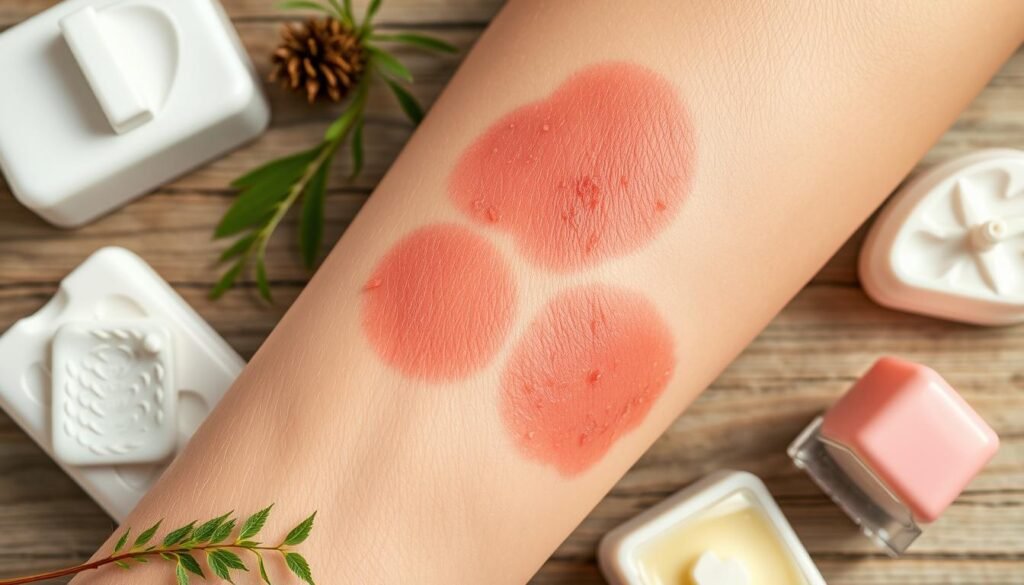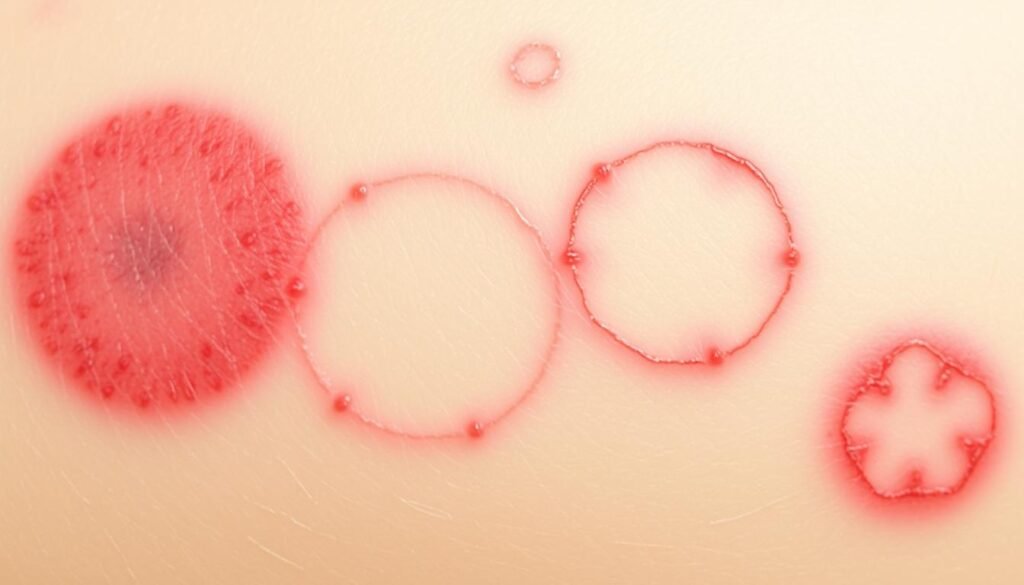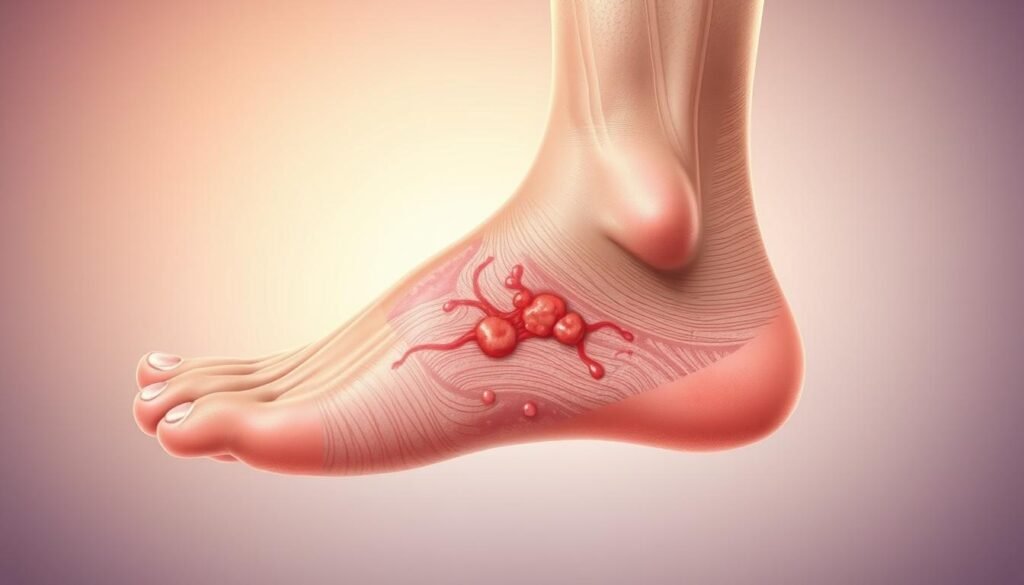Did you know about 31.6% of U.S. adults might face eczema during their life? This skin issue comes in many forms, each affecting lives differently. Knowing each type is key to taking back control. Atopic Dermatitis, the most common kind, and others like Nummular Eczema, change the day-to-day for many. By identifying them, people can get the right help, improving their life quality significantly.
Key Takeaways
- Eczema affects around 31.6% of adults in the U.S.
- Understanding different types aids in effective management.
- Atopic Dermatitis is the most common form of eczema.
- Contact Dermatitis can be triggered by irritants and allergens.
- Recognizing symptoms is key to seeking timely treatment.
- Effective management strategies include both topical treatments and lifestyle changes.
- Awareness of potential triggers can help prevent flare-ups.
What is Eczema?
Eczema is a group of conditions making skin dry, itchy, and red. It can affect anyone, bringing many challenges. It’s often linked to allergies and asthma, so knowing what eczema is helps manage it better.
Eczema’s causes are complex, involving genes and environment. Triggers like allergens, stress, and weather changes impact it. Knowing what sets off your eczema is crucial for control.
Understanding eczema means knowing its signs and what causes it. This knowledge aids in seeking the right treatment and improving life quality.
| Aspect | Details |
|---|---|
| Definition | A term denoting a variety of inflammatory skin disorders. |
| Common Symptoms | Dryness, itching, and inflammation. |
| Associated Conditions | Allergies and asthma. |
| Eczema Causes | Genetic predisposition and environmental factors. |
| Common Triggers | Irritants, allergens, stress, and climate changes. |
Types of Eczema
Eczema is a term for several skin conditions with distinct features and signs. Knowing the various kinds helps people tell them apart. This leads to better ways to manage and treat them. Here, we give a summary of common eczema types to improve identification and understanding.
Overview of Different Types
There are many eczema types, each with its own traits and affected groups. The most known are:
- Atopic Dermatitis: Mostly found in kids, this long-term issue causes a lot of itchiness and redness.
- Contact Dermatitis: Comes from contact with allergens or irritants, leading to red and blistering skin.
- Seborrheic Dermatitis: Affects oily parts of the body, resulting in scaly areas.
- Nummular Eczema: Features round, coin-like spots on the skin.
- Dyshidrotic Eczema: Brings small, itchy blisters on the palms and soles.
- Stasis Dermatitis: Caused by bad blood flow, it makes the lower legs swell and irritate.
- Neurodermatitis: Starts from itching or scratching, leaving thick, scaly patches.
How to Identify Each Type
Finding out the exact eczema type needs close watching. Key things to look for include:
- Timing of onset: When does it show up? After touching certain things or during certain times of the year?
- Appearance of lesions: What do they look like? Are they dry, bumpy, or filled with fluid?
- Typical locations: Where on the body does it happen? Different kinds prefer different spots.
For in-depth info on eczema types, symptoms, and treatments, visit this resource. Knowing about these types makes getting the right help easier.
Atopic Dermatitis
Atopic dermatitis is also called atopic eczema. It’s a common skin problem starting in childhood and sometimes lasts into adulthood. People with family histories of allergies or asthma are more likely to get it. Knowing more about atopic dermatitis helps understand its causes and symptoms.
Understanding Atopic Dermatitis
Atopic dermatitis means the skin can’t hold moisture well or guard against irritants. This problem causes severe itching, redness, and dry skin. Those with atopic dermatitis often deal with repeated episodes of skin discomfort. Research shows they may react badly to things in their environment. It’s crucial to know how to handle these triggers.
Symptoms and Triggers
Typical symptoms of atopic dermatitis are:
- Intense itching
- Red patches on the skin
- Dry and scaly skin
Several environmental factors can set off these symptoms, including:
- Pollen
- Dust mites
- Some foods, like eggs and peanuts
Knowing about these symptoms and what triggers them is key in managing atopic eczema.
| Symptom | Description |
|---|---|
| Intense Itching | Severe itching that interferes with daily living and sleep |
| Red Patches | Inflammation that can show up on different body parts |
| Dry Skin | Skin that’s rough and might crack or peel |
Contact Dermatitis
Contact dermatitis happens when skin touches certain substances, leading to inflammation. Knowing the types of contact dermatitis is key to handling it well. We’ll look into irritant dermatitis and allergic contact dermatitis, their causes, and prevention tips.
Types of Contact Dermatitis
There are two main types of contact dermatitis:
- Irritant Dermatitis: This results from skin damage due to irritants like soap, detergents, or chemicals. Symptoms include redness, itching, and a burning feel.
- Allergic Contact Dermatitis: This occurs when skin contacts an allergen like latex, fragrances, or metals such as nickel. Symptoms like hives, blisters, or intense itching appear after repeated exposure.
Causes and Prevention
Finding out what triggers contact dermatitis is essential for prevention. Here are some common irritants and allergens:
| Type | Common Triggers | Prevention Measures |
|---|---|---|
| Irritant Dermatitis | Soaps, detergents, solvents | Avoid harsh chemicals, use gloves |
| Allergic Contact Dermatitis | Latex, fragrances, nickel | Avoid known allergens, wear protective clothing |
By taking preventive steps, you can lower the chance of getting contact dermatitis. It’s important to know what your skin reacts to. Staying away from these triggers is crucial. Dermatology clinics emphasize understanding these triggers for better skin health.

Seborrheic Dermatitis
Seborrheic dermatitis is a skin issue that shows up where the skin is oily. This includes areas like the scalp, face, and upper back. People often think it’s just dry skin. However, it actually causes flaking, redness, and itching. Dandruff is a common symptom when it’s on the scalp.
What is Seborrheic Dermatitis?
The yeast Malassezia is mainly to blame for seborrheic dermatitis. This yeast loves oily skin and can make the skin inflamed. This results in the usual symptoms. The problem can get worse with stress and changing weather for those with oily skin.
Seborrheic dermatitis isn’t alone; it can come with other skin issues like psoriasis. This shows they might be connected. Treating it can mean using special shampoos and creams. These are chosen based on what works for your skin and symptoms.
| Treatment Type | Description | Effectiveness |
|---|---|---|
| Medicated Shampoos | Shampoos with pyrithione zinc, ketoconazole, or selenium sulfide. They help reduce inflammation and control yeast. | High |
| Topical Antifungals | Creams or lotions that fight fungus, applied directly on the skin. | Moderate to High |
| Hydrocortisone Creams | These creams use corticosteroids to ease inflammation and itch. | Moderate |
Nummular Eczema
Nummular eczema stands out because of its round, coin-like patches on the skin. These patches often stem from dry skin triggers. People with nummular eczema see these spots on different body parts, causing worry and discomfort.
Characteristics of Nummular Eczema
Its key trait is coin-shaped lesions of various sizes. These itchy patches make you want to scratch, which can make things worse. Sometimes, inflammation leads to redness and crusting. Knowing these signs is vital for managing the condition effectively.
Management Strategies
Good skin care is crucial for managing eczema. Using emollients keeps the skin moist, helping prevent outbreaks. Doctors might suggest topical steroids to ease inflammation.
Making simple changes, like avoiding harsh fabrics and using gentle soaps, also helps. These steps improve control over the condition and reduce discomfort.

Dyshidrotic Eczema
Dyshidrotic eczema shows up chiefly on the hands and feet as blisters filled with fluid. These blisters can really hurt and make you itch a lot. People who get this type of hand eczema see it flare up for different reasons.
Common causes of flare-ups in dyshidrotic eczema are:
- Moisture and humidity
- Excessive heat
- Stressful situations
Keeping your skin moist is key to handling this skin issue. If your skin gets dry, symptoms might get worse. You should often use skin creams and avoid things that might irritate your skin, like strong soaps.
Lots of treatments exist for those dealing with dyshidrotic eczema. Using creams that fight swelling can really help. Covering the creamed area with plastic wrap or gloves can make these creams work better.
| Management Strategies | Description |
|---|---|
| Topical Treatments | Corticosteroids to reduce inflammation |
| Occlusion | Wrapping treated areas to enhance effectiveness |
| Skin Care | Using emollients to maintain hydration |
| Avoiding Irritants | Steering clear of harsh chemicals |
When you understand and use these strategies, managing dyshidrotic eczema gets easier.
Stasis Dermatitis
Stasis dermatitis affects the lower legs due to poor circulation. It causes symptoms like redness, swelling, and itching. This happens because fluids build up and cause inflammation. The problem often starts with venous insufficiency. This is when veins can’t send blood back to the heart well.
Factors like age, obesity, and leg injuries can make it worse. If not treated, it may lead to serious problems like leg ulcers.
What Causes Stasis Dermatitis?
Venous insufficiency is the main trigger for stasis dermatitis. Damaged vein valves are often to blame. Other factors that contribute are:
- Age-related weakening of vein walls
- Genetic predisposition to venous disorders
- Prolonged periods of standing or sitting
- Obesity, which increases pressure on leg veins
Ignoring venous insufficiency can make symptoms worse. It can also cause more severe issues like leg ulcers.
Treatment Options
Treating stasis dermatitis means improving circulation and caring for the skin. Here are some ways to do it:
- Compression therapy: Compression stockings reduce swelling.
- Topical treatments: Corticosteroid ointments help with inflammation and itching.
- Leg elevation: Lifting your legs aids blood flow back to the heart.
- Skin care: Moisturizers keep skin from cracking and getting infected.
In tough cases, you might need medical help for the venous insufficiency. Catching and treating stasis dermatitis early is key to avoiding more problems.

| Treatment Options | Purpose |
|---|---|
| Compression Therapy | Improve blood circulation and reduce swelling |
| Topical Corticosteroids | Decrease inflammation and relieve itching |
| Leg Elevation | Enhance venous return to the heart |
| Skin Moisturizers | Prevent cracking and potential infection |
Neurodermatitis
Neurodermatitis is a long-term skin issue that brings intense itching and scratching. It often hits specific spots like the neck, wrists, and behind the ears. People with this condition feel a strong need to scratch. This leads to a harmful itch-scratch cycle. Scratching makes the skin even more irritated, causing more itching and scratching.
Treating neurodermatitis well means looking at the whole picture. We must deal with both the skin problem and the mental and emotional sides. Handling stress and emotional triggers is key to stop the itch-scratch cycle. It helps get lasting relief. Recent research shows it’s crucial to care for both your mind and skin together. This approach is confirmed to be effective by top dermatology studies.
- Identify triggers that lead to scratching.
- Implement a skincare routine to soothe affected areas.
- Consult a dermatologist for personalized treatment plans.
- Seek therapy or counseling to manage emotional stressors.
Common Symptoms of Eczema
Eczema brings many challenges for those who have it. It’s important to know its symptoms. Knowing these can help manage the condition better. Look for red, dry, and itchy skin. This can also include oozing or a crusty surface. Some people get thick skin from a lot of scratching due to irritation.
Physical Symptoms to Look For
Common physical symptoms of eczema include:
- Red patches on the skin
- Extreme itchiness
- Dry and flaky skin
- Oozing or crusting areas
- Thickened, leathery skin due to prolonged irritation
These symptoms can be very uncomfortable. It’s crucial to understand them. This helps deal with the emotional impact of eczema.
Psycho-Social Effects of Eczema
Eczema impacts more than just the skin. It can hurt how people feel about themselves. This can lead to low self-esteem and anxiety, especially when others can see it. The emotional side of eczema includes:
- More stress from feeling self-conscious
- Feeling alone in social settings
- The possible start of depression
Experts highlight the importance of tackling these emotional issues. They suggest a caring approach to treatment and support. For deeper understanding of eczema, check out Mayo Clinic for more information.
How to Manage Eczema
Effective eczema care involves using both topical treatments and simple home remedies. Knowing how to use these methods can really help people with eczema feel better. It’s also key to know when it’s time to get help from a doctor to keep your skin healthy.
Topical Treatments and Home Remedies
For eczema, common skin treatments include corticosteroids and calcineurin inhibitors. Creams like hydrocortisone lessen redness and soothe the skin. On the other hand, products like tacrolimus tackle eczema flare-ups without the downsides of steroids. These treatments depend on how serious the eczema is.
Adding home remedies can boost eczema care. Moisturizers are crucial for keeping the skin from getting dry, which can make eczema worse. Using natural oils, such as coconut or tea tree oil, can also help because they reduce inflammation. Checking out various treatments and remedies allows people to customize their eczema management.
When to Consult a Doctor
Knowing when to see a doctor for eczema is important. You should get medical advice if eczema keeps up despite treatment or if it starts to really affect your daily life. Signs of infection, like more redness, pus, or fever, mean you should see a doctor right away. Regular visits with a healthcare provider help make sure your treatment plan works well, including trying new treatments as they come out.
| Management Strategy | Description | When to Use |
|---|---|---|
| Corticosteroids | Reduces inflammation and soothes irritation. | For acute flare-ups |
| Calcineurin Inhibitors | Controls symptoms without long-term steroid use. | For maintenance therapy |
| Moisturizers | Hydrates skin and prevents dryness. | Daily use |
| Natural Oils | Offers anti-inflammatory benefits. | As needed for additional relief |
| Consultation | Professional advice for severe or persistent cases. | If symptoms worsen or do not improve |
Conclusion
This eczema guide has shed light on different eczema types and their key traits. Whether it’s atopic dermatitis, contact dermatitis, or seborrheic dermatitis, understanding each type is crucial. Knowing the symptoms and triggers helps create effective treatment plans.
Managing eczema includes medical treatments and lifestyle changes. It’s important for patients to learn about their condition and talk to doctors. Through open communication, they can find the best strategies for their needs.
Knowing more and making informed choices helps those with eczema tackle its challenges. Adopting a whole-health approach boosts their life quality. It’s about focusing on overall well-being while dealing with eczema.